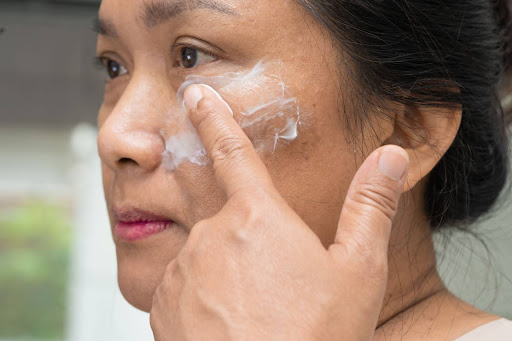Melasma, often called the “mask of pregnancy,” is a prevalent skin condition characterized by the appearance of dark patches on the face. It typically results from a combination of factors, including sun exposure, hormonal changes, and genetics, and is more commonly seen in individuals with darker skin tones. If you’re looking for ways to manage this condition, know that you’re not alone.
In this article, we explore effective treatments such as laser therapy, chemical peels, microneedling and topical solutions like hydroquinone and tranexamic acid. With the right approach and professional guidance, achieving a smoother, more even complexion is possible.
What is Melasma?
Melasma is a common skin condition that causes brown or gray-brown patches to appear, usually on the face. It is primarily triggered by sun exposure, hormonal fluctuations (such as pregnancy or birth control pills), and genetics. Melasma is more common in individuals with darker skin tones and can be challenging to manage without appropriate treatment and sun protection.
Types of Melasma
Melasma is classified into three types based on its depth:
- Epidermal Melasma: Pigmentation is confined to the outer layers of skin, making it more responsive to topical treatments.
- Dermal Melasma: Pigment is deeper within the dermis, often requiring advanced interventions like laser therapy.
- Mixed Melasma: A combination of both types, requiring a combination of treatments for optimal results.
What Causes Melasma?
Melasma arises from melanin production abnormalities in the skin. It is often triggered by sun exposure, hormonal fluctuations, and certain medications. Key contributors to melasma include:
- Hormonal changes: Pregnancy, hormone replacement therapy, and birth control pills can lead to the development of melasma. These hormonal shifts stimulate melanocytes, the cells that produce melanin.
- Exposure to sunlight and visible light: Ultraviolet (UV) and blue light exposure can worsen melasma. People with darker skin types are particularly susceptible because of their skin’s higher melanin content.
- Thyroid disease: Conditions such as hypothyroidism can affect hormone levels, contributing to the condition.
- Genetics: A family history of melasma increases the risk of developing this common skin disorder.
How to Treat Melasma
Treating melasma requires a multi-faceted approach tailored to your skin type, triggers, and the type of melasma. Here are the most effective treatments:
Laser Treatment
Laser therapy is a highly effective solution for melasma, targeting pigmentation at its source in the deeper layers of the skin. The PicoWay laser, with its ultra-short picosecond pulses, breaks down excess melanin into tiny particles, allowing the body to eliminate them naturally. This advanced technology is especially beneficial for stubborn melasma, delivering noticeable results with minimal downtime when performed by experienced professionals.
Microneedling
At Clinique Face MD, we provide microneedling as a powerful solution for treating melasma. This advanced procedure boosts collagen production and promotes skin cell renewal, effectively minimizing the appearance of dark patches. Our skilled team is dedicated to delivering personalized care, guiding you through each step of the process to achieve radiant, even-toned skin and optimal results tailored to your needs.
Chemical Peels
Chemical peels offer a powerful solution for reducing the appearance of melasma by gently exfoliating the outer layers of skin. At Clinique Face MD, our personalized peels penetrate deep into the skin, breaking down excess pigment and promoting cell turnover. Our experienced team will carefully assess your skin and guide you through each step, ensuring a safe and effective treatment tailored to your needs.
Topical Treatments
Topical therapy is often the first line of defense against melasma. Common options include:
- Combination of hydroquinone, tretinoin, and corticosteroids (triple creams): Known as the gold standard, these formulations reduce pigmentation effectively.
- Tranexamic acid: This option inhibits melanin synthesis and is available in both topical agents and oral medications.
- Alternative to hydroquinone: For those who experience adverse effects from hydroquinone, options like azelaic acid, kojic acid, and lactic acid can help lighten darker patches.
- Vitamin C (L-ascorbic acid): Reduces pigmentation and enhances collagen production, contributing to healthy skin.
- Alpha-hydroxy acids: Promote skin cell turnover, improving the appearance of dark spots and age spots.
Oral Medications
- Tranexamic Acid: Tranexamic acid, available in pill form, has been used off-label to treat melasma. It works by reducing melanin production and improving blood vessel function in affected areas. This treatment is generally reserved for cases that do not respond to topical therapies and should only be taken under medical supervision due to potential side effects, such as an increased risk of blood clots.
- Hormonal Adjustments: Hormonal fluctuations, such as those caused by birth control pills, pregnancy, or hormone replacement therapy, can trigger or worsen melasma. Adjusting or discontinuing hormone-related medications under the guidance of a healthcare provider may help alleviate symptoms, depending on the individual’s health needs and circumstances.
- Medications Linked to Melasma Triggers: Certain medications, such as antiseizure drugs (e.g., phenytoin), can contribute to pigmentation changes. If melasma is suspected to be a side effect of a medication, switching to an alternative treatment under medical advice may improve the condition.
Sun Protection
Strict sun protection is critical to prevent and manage melasma. Daily use of a broad-spectrum sunscreen with a very high protection factor (SPF) shields against UV light and visible light. Look for sunscreens containing iron oxides to block blue light and chemical sunscreen for lightweight coverage. Wear wide-brimmed hats, sunglasses, and protective clothing to limit sun exposure.
Skin Care Products and Camouflage
Incorporating cosmetic products designed for skin conditions like melasma can enhance results. Skin camouflage products conceal dark patches, improving confidence while undergoing treatment. Look for topical creams with ingredients like ferulic acid to boost efficacy.
Find the right melasma treatment
Lifestyle Adjustments for Managing Melasma
Managing melasma extends beyond treatments. Adopting these lifestyle changes can help:
- Avoid tanning beds: UV exposure from tanning accelerates the development of melasma.
- Maintain a skin-healthy diet: A diet rich in nutrients supports skin cell turnover and repair. Consider vitamin D supplements to counter reduced sun exposure.
- Practice strict sun protection: Minimise exposure to sunlight during peak hours and reapply sunscreen frequently.
- Reduce hormonal triggers: Discuss alternatives with your doctor if you’re using hormonal contraception or hormone therapy.
Book a Melasma Treatment Session in Montreal
At Clinique Face MD, we provide a wide range of medispa and cosmetic services designed to help you look and feel your best. Our treatments are tailored to your unique needs, ensuring personalized care in a welcoming and professional environment.
Whether you’re looking to refresh your skin, address specific concerns, or enhance your natural beauty, our team is here to guide you every step of the way. We combine advanced technology with proven techniques to deliver results you’ll love. Let us help you achieve your goals with treatments designed to bring out your confidence and radiance!





